Site menu:
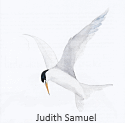
June 2017 Newsletter
Little Terns and Sea Holly - Review.
Colour Ring Report.
May Bird News.
Forthcoming Events.
Latest Newsletter.
Little Terns and Sea Holly - Review.

Whilst researching for last month's Little Terns at Gronant article I came across this delightful book. It is a comprehensive diary with sketches describing three years visiting Gronant during which Judith Samuel spent much time wardening, as well as writing up her experiences and drawing what she saw. It gives a delightful insight into the Little Terns and the life of a voluntary warden, she also describes the other wildlife, and plants, she saw, both at Gronant and nearby sites.
The book can be purchased at:
http://www.penlanpublishing.com/buy-now/
or at Amazon.co.uk.
With Judith's kind permission I reproduce three extracts from her book below, with a couple of her sketches:
The Beginning!So this is the story of how these
fascinating, annoying birds have
increasingly insinuated themselves into three whole years of my life,
years which have seen a growing obsession, particularly with little
terns, and with their summer-time life on the dunes at Gronant Reserve,
Denbighshire, North Wales. I started with starry-eyed optimism in my
own capabilities, believing that with a life-time's interest in birds I
was well placed to carry out this self-inflicted research. I soon found
out how little I did know, and I continued as an observer until I found
that my perspective had subtly shifted to one of a feeling of
responsibility, and even guilt, for human interference has wiped out so
many species and our best efforts at rectifying that feel so
insufficient, sometimes. So I have decided to compile my experiences
into a book, using the benefit of hindsight (always a useful quality)
to compare the three years. Although written as a diary it
has been ruthlessly edited — I went many more times than are actually
recorded below — because year after year some things are constant,
although others are startlingly different. 7th June (1st year)Many terns are now sitting on
nests, male and female take the nursing
in turn. All the sitting birds in a locale tend to rise up together in
a group, fly around chirruping to each other stretching their wings,
then fly like hell straight out to sea to find something to eat. The
others sit on the beach for a little when they come in, then eventually
go and hover over the nest, often, though not always, going 'wheeeeep'
as they descend, have a good look round, sit down, then eventually sink
down into what seems like the height of little tern relaxation like
slipping into a hot bath. Sometimes they even have a short nap on the
nest. As it is a hot day, one incoming tern goes for a bath in a
shallow pool, only to be joined by another then another until seven or
eight are all luxuriously splashing about together. There is still the
odd desperate bachelor who comes in with his sand eel, which he wiggles
suggestively at a hapless female, the tern equivalent to the gold
medallion and chest hair look. Inevitably rejected he goes
round to female after female, only to be told to get lost,
though in tern language of course. Now he looks like the nerd at the
disco who turned up in a tweed jacket. It's both funny and
sad. 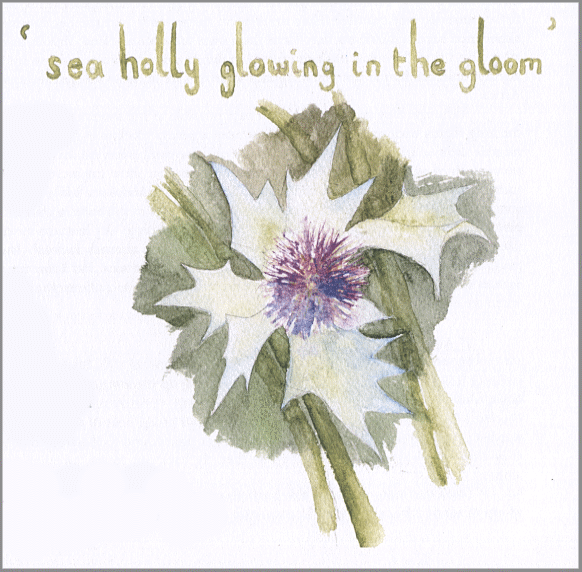
5th July (2nd year)I walk along the beach, it is quiet, birds sitting silently on nests. Then I hear an enormous chattering getting louder and suddenly I am in the midst of a huge crowd of little terns overhead, wheeling and yelling, coming in from fishing duties. They settle on the beach to rest, clean their feathers and have a quick bath. There are many fledglings on the spit at the end so I come back the way I came, along the beach. As I retreat another couple incautiously strides past and I watch in fascination as they get close to the fledglings, when two parent birds, who have obviously been keeping an eye on them, start flying round yelling at them, circling lower and swooping low over their heads, taking the occasional nip. At this point the humans notice the commotion they are causing and retreat in some alarm. Judith Samuel P.S. note there are two guided walks around the Little Tern Colony in June, see forthcoming events below for details. |
Colour Ring Report
Black-tailed Godwit Spring Migration

Right: RLflagB-LR at Burton Mere Wetlands April 25th (Richard Smith).
Both of these birds are first time visitors to the Dee estuary. L//R-RN was ringed in Langstone Harbour on the south coast of England in 2008 and most records for this bird have been from there subsequently. RLflagB-LR is the first Netherlands ringed bird we've logged in the Dee estuary, ringed in NW Netherlands in March 2014. It has also been recorded in both Portugal and France.
In late winter and early
spring Icelandic Black-tailed Godwits tend to
congregate in
south-east England (e.g. Thames estuary and the Ouse Washes) and the
Netherlands. Being strong flyers they are easily capable of flying from
there directly to Iceland, a distance of just over 1,000 miles. Some
years, however, they meet strong head winds and 2017 was one of those
years and this meant that many birds paused here on the Dee estuary to
rest and feed-up for a while before resuming their
journey.
Hundreds were counted at Caldy, Burton Mere Wetlands and Connah's Quay during late April and by this time they were in full breeding plumage making for a stunning sight. We logged a total of 22 colour-ringed birds. 2013 was another year when the spring migration was delayed by adverse winds and we had a similar numbers of colour-ringed birds then, 23, and it's interesting to compare the two years.

As the bar chart shows the make up of birds, in terms of where they spent the winter, was markedly different. Of, course they may not have flown directly from these wintering areas as many birds seem to relocate in late winter/March – so, for example, many Spanish/Portuguese birds relocate to the Netherlands and many Irish and Dee birds relocate to the SE of England. In 2013 65% of the colour-ringed birds we saw had visited the Dee estuary before (at some time of the year) whilst in 2017 only 32% had visited the Dee before. Perhaps the most interesting difference is the number of records (or ‘godwit days’) with a total of 192 in 2013 and just 30 in 2017. In other words in 2013 many birds were here for several days whilst in 2017 the majority were recorded on just the one day before moving further north - they were obviously in a hurry in 2017. We don't know why there was a difference in the two years but it will probably be something to do with the exact wind direction and strength, and the timing of those winds.
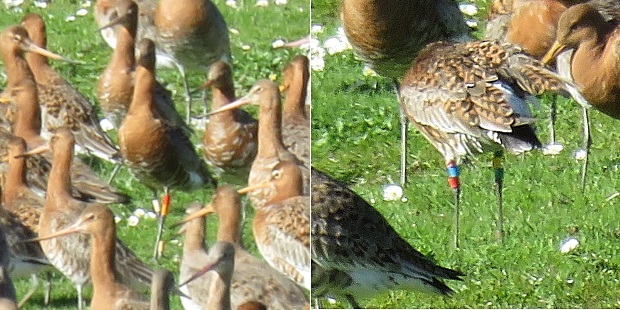
There were some interesting movements with two colour ringed
birds, RO-W//W
and RBR-GYG, present all day at Caldy on April 23rd turning up at Tiree
in the Hebrides the next day, presumably having flown overnight. John
Bowler, RSPB officer on Tiree, said that there was a record number of
Black-tailed Godwits on the island with 2,270 by the April 25th, but
again they appeared not to be staying more than a day or two before
moving on.
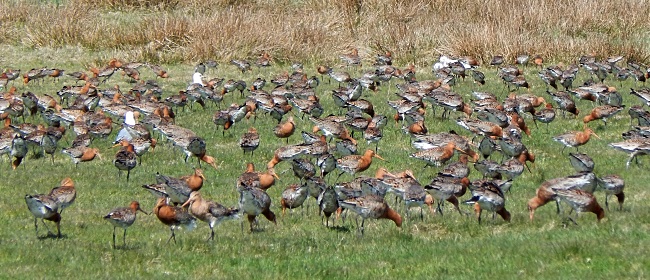
So it appears the migration was being slowed but not stopped, and before the end of April we were already hearing that three of the regular Dee Estuary birds had safely reached Iceland with YN-RX arriving in northern Iceland on April 28th and likewise R8-WO on the 30th, whilst YW-GL had made it to south-west Iceland by May 4th.
Acknowledgements and Further Reading
1. Apart from the godwits themselves the main inspiration for this article came from Graham Appleton's WADERTALES Blog, in particular 'Waiting for the wind - spring flocks of Black-tailed Godwits in Scotland', March 2017.
2. Thanks to all those who sent me their colour ring records this spring including: Steve Hinde, Rick and Elis Simpson of Wader Quest, Richard Beckett, Matt Thomas, Colin Schofield, Peter Haslem and Les Hall.
3. Thanks to all those who sent us feedback: Jenny Gill, Pete Potts, Raymond Duncan, Vincent Lelong, Phillipe Delaporte, Böğvar Şórisson and Jos Hooijmeijer.
4. See article - Black-tailed Godwits at the 'Caldy Wildfowl Collection' April and May 2013, August 2013 Newsletter, www.deeestuary.co.uk.
If you see a colour-ringed Black-tailed
Godwit please feel free to contact me:

There are several colour ringing schemes, I am happy to either
send in the
details myself
or advise which scheme the bird you've seen belongs to. I can also
email you the 'Illustrated Key For Black-tailed Godwits' Colour Ring
Schemes'. The ringers and people administrating the schemes
are
all volunteers, feedback is usually fairly prompt but during busy times
can take a few weeks.
May Bird News
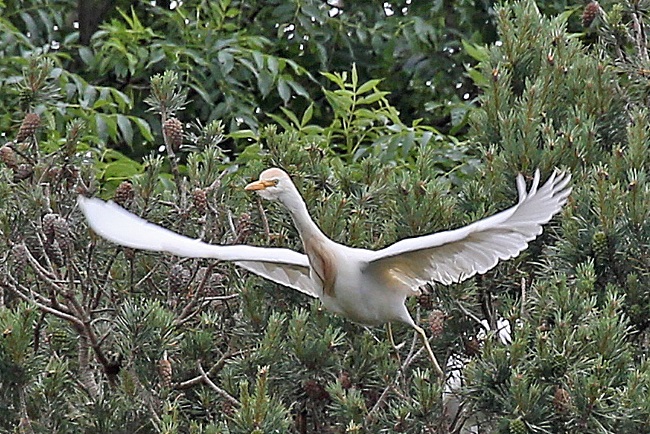
The big story of the month must be the confirmed breeding and successful hatching of Cattle Egrets at Burton Mere Wetlands, there were a total of six adult Cattle Egrets there and this follows the influx of this species into the country late last year (see Egrets Galore). The first and only other confirmed breeding of Cattle Egrets in this country was in 2008 in Somerset, following an even larger influx in 2007/8. The only other breeding probably took place in the south-west of the country in 2009 when a pair was seen with a fledged young.
Looking at the photo below it seems
that Mediterranean Gulls may also be breeding at Burton Mere Wetlands,
although I haven't heard any confirmation of that.
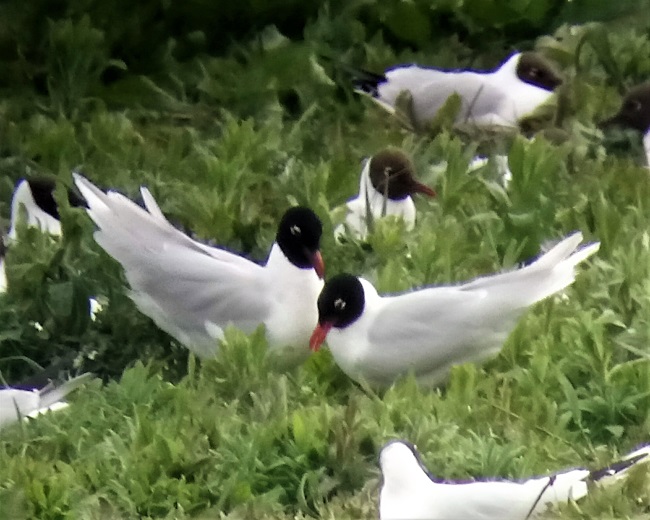
May is often a good month for rarities but this year was exceptional
with: a Spotted Crake at Red Rocks (1st), a Sub-alpine Warbler at Red
Rocks (10th), a Shorelark on Hilbre (14th to 25th), a Hoopoe at West
Kirby (16th), a Buff-breasted Sandpiper at Burton Mere Wetlands (19th
to 21st), a Turtle Dove at Red Rocks (22nd to 24th) and a Roseate Tern
off Leasowe Lighthouse (23rd).
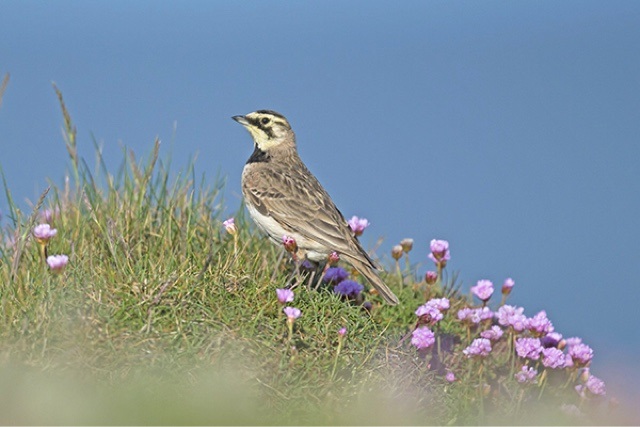
Hilbre Bird Obs Blog
The highlight of the wader migration were seven Curlew Sandpipers over
Hilbre on the 13th which we think is probably a record high number for
spring on Hilbre, there were a further two singles seen during the
month. There was a total of eight Little Stints spread right across the
estuary including Gronant, Burton Mere Wetlands, Hilbre, Hoylake and
Meols. As
usual Heswall was the best place to see Whimbrels and there was a
massive count of 131 there on the 2nd.
With good weather virtually all month the Little Terns at Gronant got off to a very early start with the first egg hatched on the 16th, which is likely to be the earliest ever recorded. Unfortunately some nests were lost during the high tides at the end of the month, but it is still very early in the season and surely they will re-lay.
Other highlights included 17 Whinchats
at Burton Marsh on the 1st,
several Grasshopper Warblers around the Boathouse Pub and Heswall Golf
Course area of Parkgate and a Blue-headed Wagtail at Leasowe Lighthouse
on the 22nd.

Top of Page
What to expect in June
June often sees an influx of immature Spoonbills and last year we had a record seven. It is usually a particularly good month for rarities and over the past three years these have included Broad-billed Sandpiper, Stone curlew, White-winged Black Tern, Red-necked Phalarope, Serin and Bee-eater.
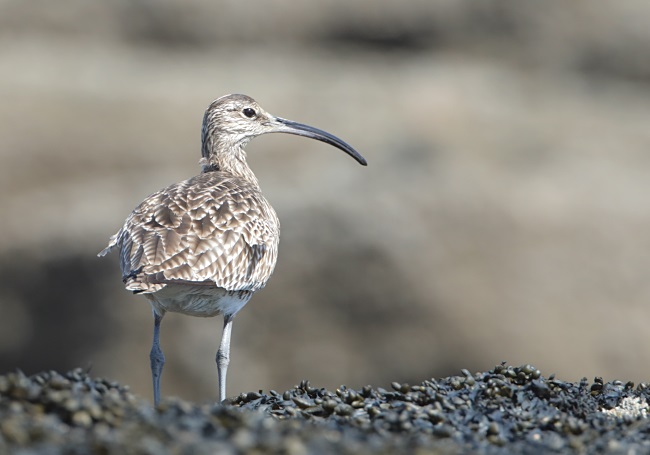
Top of Page
Forthcoming Events
June Highest Spring Tides (Liverpool)
Also
see Tides
page.
24th June, 11.54hrs (BST), 9.7m.
25th June, 12.45hrs (BST), 9.7m.
26th June, 13.35hrs (BST), 9.6m.
Forthcoming Events
Organised by the Wirral
Ranger Service , Flintshire
Countryside Service and the
RSPB (Dee Estuary):
All these events and walks have bird interest, even those not
advertised specifically for birdwatching. No need to book for these
events unless specified - please check below.
1 pm start.
Price: Free (normal reserve entry charges apply to non-members).
Join
one of our friendly, knowledgeable volunteers for a leisurely amble
around much of Burton Mere Wetlands, including the unmissable viewpoint
at the end of the Hillfort Trail on Burton Point. Take in the sights
and sounds, learn more about the wildlife that thrives here, the work
we do to give nature a home and the remarkable history of the estuary.
Great
for first time visitors or those looking to brush up on their
identification skills; with constant changes as we move through the
seasons, it's impossible to predict what might be seen. Summer may be a
quieter time for birds since they finish defending territories as
breeding season ends, but the growing avocet chicks and fledged little
egrets and herons loafing close to the hides are great to watch. Warm
sunny days will bring out the various dragon and damselflies that make
their home on the reserve, along with butterflies and basking common
lizards! Some birds begin their return migration just as we are getting
settled into summer so sometimes unexpected birds may be found.
No
booking required, just turn up on the day. A reasonable level of
fitness and sturdy footwear are required. Walks typically last up to 3
hours, weather permitting.
Ring 0151 353 8478 for further details.
10am to Noon.
Join
the Wardens on a guided walk of the Little Tern Colony at Gronant Sand
Dunes and learn all about these fascinating seabirds. Bring sturdy
shoes or boots, Gronant sand dunes are exposed to the weather coming
off Liverpool Bay so bring suitable clothing.
Meet at the car park opposite the
Crofter’s Cafe on Shore Road, Gronant.
This event is free and no need to book, for further details ring 01352
810614
or 01745 356197.
Friday 30th June,
Seabird Friday at Gronant.
10am to Noon.
Join
the Wardens on a guided walk of the Little Tern Colony at Gronant Sand
Dunes and learn all about these fascinating seabirds. Bring sturdy
shoes or boots, Gronant sand dunes are exposed to the weather coming
off Liverpool Bay so bring suitable clothing.
Meet at the car park opposite the
Crofter’s Cafe on Shore Road, Gronant.
This event is free and no need to book, for further details ring 01352
810614
or 01745 356197.
